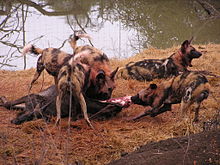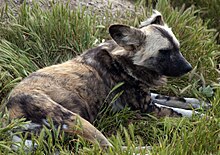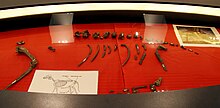 Lycaon pictus is a canid found only in Africa, especially in savannas and lightly wooded areas. It is variously called the African wild dog, African hunting dog, Cape hunting dog, painted dog, painted wolf, painted hunting dog, spotted dog, or ornate wolf.
Lycaon pictus is a canid found only in Africa, especially in savannas and lightly wooded areas. It is variously called the African wild dog, African hunting dog, Cape hunting dog, painted dog, painted wolf, painted hunting dog, spotted dog, or ornate wolf.Anatomy and reproduction

The scientific name "Lycaon pictus" is derived from the Greek for "wolf" and the Latin for "painted". It is the only canid species to lack dewclaws on the forelimbs.
This is the largest African and, behind only the gray wolf, is the world's second largest extant wild canid. Adults typically weigh 18–36 kilograms (40–79 lb). A tall, lean animal, it stands about 75 cm (30 in) at the shoulder, with a head and body length of 75–141 cm (30–56 in) plus a tail of 30 to 45 cm (12 to 18 in). Animals in southern Africa are generally larger than those in eastern or western Africa.
There is little sexual dimorphism, though judging by skeletal dimensions, males are usually 3-7% larger. It has a dental formula of
| Dentition |
|---|
| 3.1.4.2 |
| 3.1.4.3 |
The African wild dog has a bite force quotient (BFQ, the strength of bite relative to the animal's mass) measured at 142, the highest of any extant mammal of the order Carnivora, although exceeded by the Tasmanian devil, a marsupial carnivore.
The African wild dog may reproduce at any time of year, although mating peaks between March and June during the second half of the rainy season. The copulatory tie characteristic of mating in most canids has been reported to be absent or very brief (less than one minute) in the African wild dog, possibly an adaptation to the prevalence of larger predators in its environment. Litters can contain 2-19 pups, though ~10 is the most common. The time between births is usually 12–14 months, though it can also be as short as 6 months if all of the previous young die. The typical gestation period is approximately 70 days.Pups are usually born in dens dug and abandoned by other animals, such as the Aardvark. Weaning takes place at about 10 weeks. After 3 months, the pups leave the den and begin to run with the pack. At the age of 8–11 months they are able to kill small prey, but depend on the pack kills for most of their food. They do not become proficient hunters until the age of 12–14 months. Wild dogs reach sexual maturity at the age of 12–18 months.
Females will disperse from their birth pack at 14–30 months of age and join other packs that lack sexually mature females. Males typically do not leave the pack in which they were born. This is unusual among social mammals, among which the core pack tends to consist of related females. Among African wild dogs, females compete for access to males that will help rear their offspring. In a typical pack, males outnumber females by a factor of two to one, and only the dominant female is usually able to rear pups. This atypical situation may have evolved to ensure that packs do not over-extend themselves by attempting to rear too many litters at the same time. The species is also unusual in that some members of the pack, including males, may be left to guard the pups whilst the others, including the mothers, join the hunting group. The practice of leaving adults behind to guard the pups may decrease hunting efficiency in smaller packs.
Social structure


Unrelated wild dogs sometimes join in packs, but this is usually temporary. Instead, unrelated wild dogs will occasionally attempt hostile takeovers of packs.
Hunting and diet

The African wild dog hunts in packs and small groups. Like most members of the dog family, it is a cursorial hunter, meaning that it pursues its prey in a long, open chase. Nearly 80% of all wild dog hunts end in a kill; for comparison, the success rate of lions, often viewed as ultimate predators, is only 30%. Schaller found that 9 of 10 wild dog hunts in the Serengeti ended in kills. Members of a pack vocalize to help coordinate their movements. Its voice is characterized by an unusual chirping or squeaking sound, similar to a bird. Wild dogs frequently kill larger prey via disemboweling, a technique that is rapid but has caused this species to have a negative, ferocious reputation. For this reason, even some early wildlife conservationists, such as Carl Akeley took pride in killing entire wild dog packs.
After a successful hunt, the hunters will regurgitate meat for those that remained at the den during the hunt including the dominant female, the pups, the sick or injured, the old and infirm, and those who stayed back to guard the pups.
The wild dog's main prey varies among populations but always centers around medium-to-large sized ungulates, such as the impala, Thomson's Gazelle, Springbok, kudu, reedbuck, and wildebeest calves. The most frequent single prey species depends upon season and local availability. For example, in the Serengeti in the 1970s wildebeest (mostly calves) were the most frequently taken species (57%) from January to June, but Thompsons gazelle were the most frequently taken (79%) during the rest of the year. In the Selous Game Reserve, the most frequent prey is impala. While the vast majority of its diet is made up of mammal prey, it sometimes hunts large birds, especially Ostriches. Other predators, such as lions, sometimes steal the prey that wild dogs catch.
Some packs are also able to include large animals among their prey, including zebras and warthogs. The frequency and success rates of hunting zebra and warthogs varies widely among specific packs. To hunt larger prey, wild dogs use a closely coordinated attack, beginning with a rapid charge to stampede the herd. One wild dog then grabs the victim's tail, while another attacks the upper lip or nose, and the remainder attempt to disembowel the animal. Male wild dogs usually perform the task of grabbing warthogs by the nose. This behaviour is also used on other large dangerous prey, such as the African Buffalo, giraffe calves, and large antelope—even the one-ton Giant Eland.
Studies indicate that this large-animal hunting tactic may be a learned behavior, passed on from generation to generation within specific hunting packs, rather than an instinctive behaviour. Some studies have also shown that other information, such as the location of watering holes, may be passed on similarly.
Distribution and threats
The home range of packs varies depending on the size of the pack and the nature of the terrain. In the Serengeti, the average dog density (prior to the local extinction of the species) was 1 dog per 208 square kilometers (80 sq mi), whereas in the Selous Game Reserve the average density was 1 dog every 25 square kilometers (9.7 sq mi). Their preferred habitat in the Serengeti is deciduous woodlands because of large prey herd size, lack of competition from other carnivores, and better sites for denning. In the Serengeti, the average range has been estimated at 1,500 square kilometres (580 sq mi), although individual ranges overlap extensively.
There were once approximately 500,000 African wild dogs in 39 countries, and packs of 100 or more were not uncommon. Now there are only about 3,000-5,500 in fewer than 25 countries, or perhaps only 14 countries. They are primarily found in eastern and southern Africa, mostly in the two remaining large populations associated with the Selous Game Reserve in Tanzania and the population centered in northern Botswana and eastern Namibia. Smaller but apparently secure populations of several hundred individuals are found in Zimbabwe (Hwange National Park), South Africa (Kruger National Park), and in the Ruaha/Rungwa/Kisigo complex of Tanzania. Isolated populations persist in Zambia, Kenya, and Mozambique.
The African wild dog is endangered by human overpopulation, habitat loss and predator control killing. It uses very large territories (and so can persist only in large wildlife protected areas), and it is strongly affected by competition with larger carnivores that rely on the same prey base, particularly the lion and the Spotted Hyena. While the adult wild dogs can usually outrun the larger predators, lions often will kill as many wild dogs and cubs at the brooding site as they can but do not eat them. One on one the hyena is much more powerful than the wild dog but a large group of wild dogs can successfully chase off a small number of hyenas because of their teamwork. It is also killed by livestock herders and game hunters, though it is typically no more (perhaps less) persecuted than other carnivores that pose more threat to livestock. Most of Africa's national parks are too small for a pack of wild dogs, so the packs expand to the unprotected areas, which tend to be ranch or farm land. Ranchers and farmers protect their domestic animals by killing the wild dogs. Like other carnivores, the African wild dog is sometimes affected by outbreaks of viral diseases such as rabies, distemper, and parvovirus. Although these diseases are not more pathogenic or virulent for wild dogs, the small size of most wild dog populations makes them vulnerable to local extinction due to diseases or other problems.
Taxonomy
Lycaon pictus is the only extant species in the genus Lycaon. An extinct species from the African Pleistocene, Lycaon sekowei, is a possible ancestor of the modern species. Another possible ancestor of these (and several other canids) from the Pleistocene of Eurasia is Xenocyon lycaonoides; this is sometimes also placed in Lycaon. Although in a lineage distinct from wolves, domestic dogs, and coyotes, wild dogs are more closely related to them than to other canids.
There are five recognized subspecies of Lycaon pictus:
- Lycaon pictus pictus
- Lycaon pictus lupinus
- Lycaon pictus manguensis
- Lycaon pictus sharicus
- Lycaon pictus somalicus
Interspecies adoption
In 2009 at the Pittsburgh Zoo, a female mixed breed domestic dog was brought in to nurse nine African wild dog pups, after the pups' mother had died. The nursing was going successfully, and the pups had gained weight. This is the first time that a domestic dog has ever been documented nursing African wild dog pups.Research and conservation links
AWCF - Lowveld Wild Dog Project
Botswana Wild Dog Research Project
Institute of Zoology Wild dog research
Cheetah & Wild Dog Conservation Planning Process
Harnas Wildlife Foundation
African Wild Dog Conservancy
Zambian Carnivore Programme
Wildlife Conservation Network

No comments:
Post a Comment